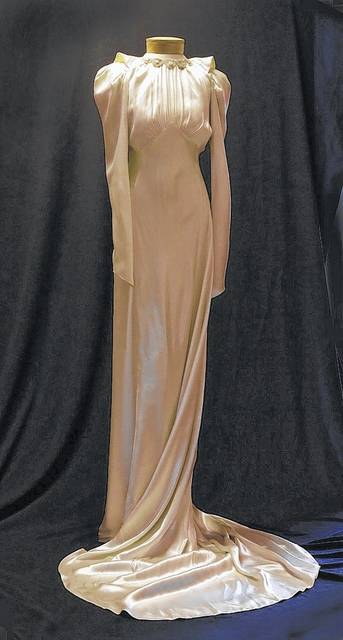
WILMINGTON — The Clinton County History Center’s new exhibit, “Here Come The Brides,” features 40 wedding dresses reflecting 160 years of wedding attire.
Early weddings in America were generally private events, held at the home of the parents of the bride or groom. These brides often had one best dress and they were generally married in that dress. It was not uncommon for brides to be married in black or other dark colors, as this best dress could also double as suitable funeral attire.
The nineteenth century bride’s desire for a white wedding dress increased rapidly in 1840, when the newly crowned Queen Victoria of Great Britain wed Prince Albert. Unlike the monarch before her, Victoria chose to be married in a splendid, white satin gown.
In reaction, young women in England and America began clamoring for white wedding dresses of their own. White wedding gowns had previously been a luxury of only the richest. It was, after all, a very difficult color to clean and maintain with nineteenth century technologies wedding dresses.
By the 1920s and 1930s, brides had largely turned to professionals to organize their weddings for them. This evolution had already been evolving for nearly 80 years; it was not until the Jazz Age that wedding vendors began to see the true monetary potential of brides and their weddings.
One of the clearest and earliest out-springs of the new concept was the introduction of bridal departments in large stores. Many stores began to offer a whole section of merchandise devoted to the bride and her big day. Around the same time, catered weddings and engraved invitations became less of a luxury for only the very rich and more of a standard that all brides should aspire to.
Wedding photographers also became a key part of the wedding and often scripted the entire progress of the wedding with their photograph prompts.
This turning of wedding preparations to the professionals created uniformity in American weddings. By the 1950s, when a white wedding was the ultimate dream for an affluent, middle class bride, the American wedding was a cookie-cutter production that could easily be replicated for another bride by the professionals who had created it.
The 1960s brought about a social evolution in which the traditional American wedding couldn’t keep up. It would not be until the 1970s that the desire for diversity and uniqueness would find its place in the American wedding.
During the 1970s, brides didn’t want the of the 1950s wedding and began to opt for more unique ceremonies and wedding garb. More and more weddings began to move out of churches, and the idea of the “destination wedding” was born.
The diversity of wedding fashion will be apparent when you attend the Clinton County History Center’s wedding exhibit, running through Dec. 15, 2017.
The Clinton County History Center is located at 149 E. Locust St., Wilmington. There is a $5 admission fee for non-members; however special arrangements can be made for groups of 8 or more.
For more information, call the Center’s curator and executive director, Kay Fisher, at 937-382-4684, or visit www.clintoncountyhistory.org


